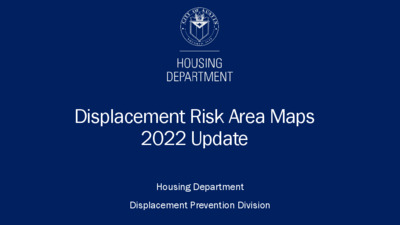Item 4-Displacement Risk Area Maps Update 2022_CDC meeting — original pdf
Backup

Displacement Risk Area Maps 2022 Update Housing Department Displacement Prevention Division Overview ▪ Analysis background ▪ Findings ▪ Next steps ▪ Q & A 2 Analysis background Uprooted Study ▪ Identify and prioritize gentrifying neighborhoods where residents are at the highest risk of displacement ▪ Matching strategies to the needs of vulnerable residents in these neighborhoods. ▪ 3-part analysis: – Vulnerability – Demographic Change – Housing Market Analysis 3 Analysis background What are the Displacement Risk Categories? ▪ Vulnerable: Vulnerable populations present, no significant demographic change, some tracts are near or contain high-value and high-appreciation areas. ▪ Active Displacement Risk: Vulnerable populations present, active demographic change, accelerating or appreciating housing market. ▪ Chronic Displacement Risk: Many vulnerable populations have been displaced, demographic changes have occurred, and the housing market has appreciated or is appreciating. 4 How do we determine Displacement Risk? ▪ Variables used to determine Displacement Risk Areas taken from ACS 5-Year Estimates (2018-2022) – % Non-white – % Children in poverty – % Population without a bachelors degree – % Renter – % Low income – Median income – Housing costs – Median home value – Median rent 5 Gentrification Type and Simplified Displacement Risk Category Vulnerable Populations Demographic Change ✓ ✓ ✓ ✓ ✓ X ✘ ✘ ✘ ✓ ✓ ✓ Housing Market Stable Gentrification Type Displacement Risk Stable Vulnerable Adjacent Susceptible Accelerating Accelerating Appreciated Appreciated Early Type 1 Dynamic Late Active Continued Loss Chronic 6 2020 Displacement Risk Areas ▪ Active Displacement ▪ Chronic Displacement ▪ Vulnerable to Displacement ▪ Historic Displacement 7 2020 Displacement Risk Areas 2022 Displacement Risk Areas ▪ Active Displacement ▪ Chronic Displacement ▪ Vulnerable to Displacement ▪ Historic Displacement 8 Findings 2020 - 2022 Comparison Typology Vulnerable Active Chronic Historical TOTAL 2020 (Census tracts) 39 2022 (Census tracts) 47 34 22 5 100 31 30 8 116 9 Project Connect Anti Displacement Dashboard 10 What’s driving the growth of Displacement Risk Areas? ▪ Large increases in housing costs drove much of the growth, especially owner-occupied – Median home values in Displacement Risk Areas increased by 34%, compared to 29% MSA Average though some areas experienced less relative growth ▪ Changes in economic and demographic factors – Median Family Income grew, especially in Chronic Displacement Risk areas – Large increase in individuals with a Bachelor’s degree across region – Small decrease in POC living in Displacement Risk Area tracts – Increase in children in poverty (end of pandemic aid) 11 Key Findings ▪ Expansion of displacement risk areas across the city ▪ New displacement risk areas are largely found on the Northern, Eastern and Southern outskirts of the city ▪ Large increase in displacement risk areas categorized as Vulnerable and Chronic. This may be due to, respectively: – Changes in demographics on the outskirts of the city – Unique conditions from last update are likely a factor (i.e. Covid pandemic, housing market spike), and increases in housing costs 12 Early Warning System Project ▪ Research project with UT; began in August 2025 and will be completed in 1.5 years ▪ Will bring together multiple datasets (i.e. utility, housing, demographic) that would allow for more frequent updates ▪ The goal is to identify properties and areas at heightened risk of displacement ▪ Aims to help the City and community partners be more proactive and better understand where risks are emerging 13 Next steps ▪ Continued evaluation and review of data and methodology ▪ The next Displacement Risk Area update will take place in early 2026 following the release of 2024 ACS 5 year estimate data in December ▪ Explore additional ways of communicating the analysis to make it even more useful to the community ▪ Once completed, the early warning system will be integrated into broader displacement prevention efforts 14 Thank you Marla Torrado, marla.torrado@austintexas.gov Will Swinton-Ginsberg, william.swinton-ginsberg@austintexas.gov